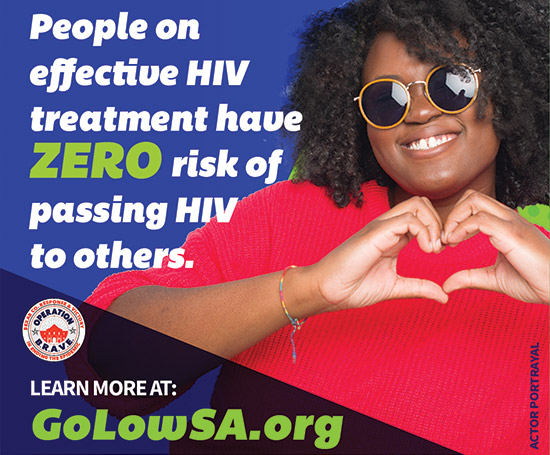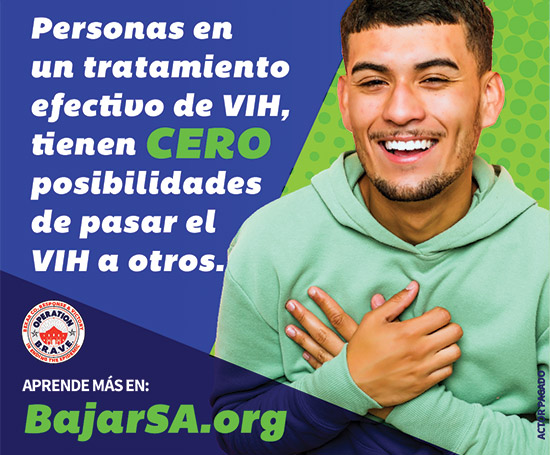
Injectable every 2 months works as well as Truvada in a study
A medication being studied for HIV prevention was found to be safe and effective in stopping the virus. Long-acting cabotegravir (CAB LA) was given as an injection once every eight weeks.
The HIV Prevention Trials Network (HPTN) was comparing CAB LA against Truvada as pre-exposure prophylaxis (PrEP). Truvada for PrEP is a once-daily pill already available on the market.
As a result of the decreased incidence of HIV seen with CAB LA, similar to that seen with the already-established Truvada for PrEP, the HPTN 083 study was unblinded in May.
This means that participants will now be told whether they are receiving CAB LA or Truvada. Those who want to change their PrEP from injection to Truvada, or vice versa, will be allowed to do so. A change to CAB LA is dependent on its availability.
HPTN 083 participants will also no longer have to take a placebo along with their PrEP medication.
“Demonstrating conclusively that long-acting injectable cabotegravir is highly effective almost two years earlier than originally expected is exciting news,” said HPTN 083 protocol chair Raphael J. Landovitz, MD, MSc, in a press release from the research network. “It is inspiring that we may soon have additional options for at-risk individuals who have difficulty with or prefer not to take pills.” Dr. Landovitz is a professor of medicine at the David Geffen School of Medicine at the University of California, Los Angeles (UCLA) and associate director of the UCLA Center for Clinical AIDS Research & Education (CARE).
The international trial enrolled nearly 5,000 cisgender men and transgender women who have sex with men. Half of the U.S. participants identified as Black or African American.
“A long-acting injectable for PrEP that does not require adherence to an oral daily pill is a great addition to the HIV prevention toolbox. Prevention strategies have never been one-size-fits-all,” said HPTN 083 protocol co-chair Beatriz Grinsztejn, MD, PhD, in the press release. Dr. Grinsztejn directs an HIV research center in Rio de Janeiro.
Kimberly Smith, MD, Head of Research and Development at ViiV Healthcare, which is developing cabotegravir, said in a company statement, “We are thrilled with the results not only because of the high efficacy of cabotegravir but also because we have demonstrated high efficacy in a study that adequately represents some of the populations most disproportionately impacted by HIV—Black MSM [men who have sex with men] in the U.S., young MSM globally, and transgender women.”
A separate study, HPTN 084, is looking at CAB LA PrEP in cisgender women in sub-Saharan Africa. Truvada for PrEP is also being used as a comparator in that trial.
Truvada, usually as part of a single-tablet regimen (STR), is also available for the treatment of HIV. CAB LA is being studied for HIV treatment as well.
Read the HPTN release at hptn.org/news-and-events/press-releases/long-acting-injectable-cabotegravir-highly-effective-prevention-hiv. A statement from the HIV prevention advocates organization AVAC (formerly the AIDS Vaccine Advocacy Coalition) is at avac.org/press-release/trial-finds-long-acting-injectable-antiviral-safe-and-effective.
Dolutegravir infant dose approved
The FDA in June approved Tivicay PD, a dispersible form of dolutegravir (brand name Tivicay) for pediatric use in ages four weeks and up, and weighing at least 6.6 to 30.8 pounds (3–14 kg)
The Tivicay PD tablets are dispersible in water (oral suspension) for pediatric doses. Dolutegravir must be taken in combination with other HIV drugs.
In addition, the FDA expanded the use of the Tivicay 50 mg tablet to children weighing as low as 44 pounds (20 kg). The previous weight low was 77 pounds (35 kg).
Dolutegravir is from the drug class integrase strand transfer inhibitor (INSTI). INSTIs are the most used drugs for HIV treatment today. Dolutegravir, however, is one of the INSTIs being most implicated in weight gain. Nonetheless, new HIV treatment options for children are always welcome.
Go to positivelyaware.com/tivicay.
Britain’s first HIV-positive mayor is Normal: Artist and shop owner Philip Normal is believed to be the first openly HIV-positive mayor in the U.K.
“I don’t know if this is true, but if it is, it is something none of us should feel pride in,” Normal was quoted as saying in the Wadsworth Guardian. “Rather, it highlights the shame and stigma that has been associated with HIV for far too long.”
Normal, 38, is the new mayor of Lambeth, a borough in south London. It has a large LGBTQ presence among its population of 300,000. Because of pandemic stay-at-home orders, Normal was appointed to the ceremonial position in May remotely from his home. A member of the U.K.’s Labor Party, he has been a councilman for the borough since 2018. He dedicates his charity work to the Albert Kennedy Trust, which supports homeless LGBTQ youth. Get a piece of history at philipnormal.co.uk/shop.
HIV-to-HIV transplant
Two cases of organ donations from one person living with HIV to another were presented at the American Transplant Congress, held virtually in May.
The first such transplant in the United States was performed at Johns Hopkins University in March 2019. POSITIVELY AWARE has reported on that transplant, in which activist Nina Martinez donated a kidney to another positive person. Martinez has been living with HIV since she was six weeks old. She continues to do well, as does the man who received her kidney. Both remain on the HIV therapy they were taking before the transplant. Martinez is listed as an author on the research abstract on the two cases presented at the conference.
The report’s conclusion states, “In the context of growing experience with HIV-to-HIV transplantation, there is strong interest in living donation among the community of people living with HIV. In fact, there is stronger interest in this population than the general population, particularly because of solidarity with the HIV community and a desire to help fellow individuals living with this condition. These two cases [the second was performed at Duke University] provide important proof-of-concept evidence that donation is possible for people living with HIV. Furthermore, the approaches used by both centers for evaluation, selection, informed consent, and follow-up are generalizable to other centers interested in expanding transplantation in this manner.”
Martinez remains committed to promoting HIV-to-HIV organ transplants. Read her article in PA at positivelyaware.com/articles/where-there’s-hope, which includes a list of resources.
International conferences update
The full program schedule for HIV2020 is now available online. The conference was originally set to be held in Mexico City, but because of the COVID-19 pandemic, will instead be conducted as a series of two-hour sessions via Zoom video meetings from July to October. Go to HIV2020.org.
A community-based conference, HIV2020 was to coincide with the International AIDS Conference, which had been scheduled to take place in the Bay Area. Rebranded as AIDS2020: Virtual, the 23rd International AIDS Conference will run July 6–10. Go to AIDS2020.org.
OI guidelines updated
The guidelines on opportunistic infections in HIV were updated in May.
In treatment of candidiasis, important new information was added on miscarriages after any exposure to the anti-fungal fluconazole, with even one dose. Other updates discuss azole resistance, the use of boric acid, and the use of gentian violet for oral candidiasis (thrush).
Herpes information has also been updated. Oral herpes is herpes simplex virus 1 (HSV-1) and genital herpes is HSV-2. There is new prevalence data for the country. HSV-1 as a cause of genital herpes is discussed, as well as prevention for HSV-2. There is additional information about interpreting HSV tests. Last but not least, there is information on treating acyclovir-resistant HSV.
The guidelines are produced by the U.S. Department of Health and Human Services (HHS). Read them at aidsinfo.nih.gov.
New resource for opioid use disorder
Essentials of Opioid Use Disorder: A Resource for Hepatologists and Infectious Disease Specialists Managing HCV and/or HIV Infection is a new guide from Clinical Care Options, in collaboration with the American Society of Addiction Medicine.
No heavy tome, the resource is a handy-dandy guide in just four pages. It packs a wallop, outlining:
• diagnostic criteria
• medications for OUD
• drug-drug interactions withHIV and HCV medications
• an algorithm on how to engage patients on potential drug use
Download the resource at bit.ly/OpioidUseDisorderResource.
Gilead sues U.S. over Truvada
Gilead Sciences has filed a breach of contract lawsuit against the U.S. government over the company’s drug Truvada. The company alleges that the Centers for Disease Control and Prevention (CDC) made four violations of agreements on HIV prevention research.
Last November 2019, the federal government filed a patent infringement lawsuit against Gilead on behalf of the U.S. Department of Health and Human Services (HHS), under which CDC operates. The suit sought “damages for Gilead’s infringement of HHS patents related to pre-exposure prophylaxis (or PrEP) for HIV prevention. Despite multiple attempts by HHS to license its patents, Gilead has refused. … The complaint further alleges that, as a result of such infringement, Gilead has profited from research funded by hundreds of millions of taxpayer dollars and reaped billions [in profits] from PrEP through the sale of Truvada and Descovy,” HHS reported.
Gilead claims the patents should never have been granted to the government. The company’s complaint alleges that it “has incurred unnecessary attorneys’ fees and suffered reputational harm” as a result of the government’s lawsuit. Gilead reported in April that through its contracts with the CDC, it agreed to “provide the CDC with significant quantities of Gilead compounds free of charge. The government, in return, agreed to promptly notify Gilead of any inventions, discoveries, or ideas that resulted from the research. In the case of the CTA [Clinical Trial Agreement], the government promised not to seek patent protection in connection with any alleged inventions that derive from the use of the study drug in the trial.”
Read Gilead’s announcement at bit.ly/lawsuitstatementGilead, and the HHS press release at bit.ly/lawsuitstatementDHHS.
Former Louisiana officer wins HIV discrimination case
A former Louisiana police officer who was denied a job as a sheriff’s deputy, allegedly because he is living with HIV, has been awarded a $90,000 settlement. Lambda Legal announced in April that it reached the settlement with the Iberia Parish Sheriff Office, in New Iberia, Louisiana.
The settlement also mandates a number of non-discrimination steps that the sheriff’s office must take.
“This settlement is a lesson to all employers across the country that HIV discrimination in the workplace is completely unlawful and has no place anywhere. Someone’s HIV status is absolutely irrelevant to their ability to safely perform a job, from the Iberia Parish Sheriff’s Office to the U.S. Air Force [sued in a separate discrimination suit], and using it to deny employment or promotion is discrimination pure and simple,” said Scott Schoettes, counsel and HIV Project Director at Lambda Legal, in a press release. “This settlement should also serve as a wakeup call to states and cities across the country to remove once and for all outdated and stigmatizing HIV criminalization laws that perpetuate discrimination and ignore current medical science.”
Lambda filed a federal lawsuit against the sheriff’s office in October 2017.
“I immediately knew that the sheriff’s decision not to hire me was based on my HIV status, and though it was a long journey, it feels good to finally be vindicated,” William “Liam” Pierce said in the release. “I hope that my case helps others avoid going through my experience and demonstrates to other employers that living with HIV has nothing to do with our ability to do any job.”
Read the press release at bit.ly/sheriffdiscrimination.


Go low, San Antonio
It’s a message everyone should know: people living with HIV who have an undetectable viral load cannot pass HIV on to their sex partners.
Now Bexar County, home to San Antonio, is telling everybody by using bright images and a simple message: “People on effective HIV treatment have ZERO risk of passing HIV to others.”
“When people with HIV take their HIV medications as prescribed, they can keep the amount of HIV in their body so low that it can’t be passed on to others,” says Operation B.R.A.V.E. (Bexar County Response and Victory in Ending the Epidemic). “In clinical terms, this is called viral suppression.”
“How Low Can You Go?” promotes “HIV treatment as a powerful tool for HIV prevention,” Operation B.R.A.V.E. said in May when it launched the new media campaign.
“According to the Centers for Disease Control and Prevention, there is proven science supporting the campaign. In three different studies, including thousands of couples and many thousand acts of sex without a condom or other HIV prevention method, no HIV transmissions to an HIV-negative partner were observed when the HIV-positive person was virally suppressed,” the campaign announcement noted.
It also mentioned the U = U campaign, which stands for “undetectable equals untransmittable.” “U = U” has become the community-based catchphrase for the medical term, “treatment as prevention” (TasP). For prevention, undetectable is considered a viral load below 200 copies, on stable therapy for at least six months, and absent any other STI.
The campaign can be found online in English at GoLowSA.org and in Spanish at BajarSA.org.
Read the campaign announcement at bit.ly/2zuDlrc.
In it, Greg Casillas, HIV-positive for 20 years, says, "When I was diagnosed, taking meds felt like the beginning of the end of my life. It was very difficult for me to accept. When I learned new HIV meds could help me live a long, normal life, I confronted the internal stigma I had created and started care. Marrying the man of my dreams meant I needed to do it for him too. By taking my meds and staying healthy, I cannot pass HIV to him. It's not a cure for HIV, but it's the next best thing."
Operation B.R.A.V.E. noted that there’s an estimated 37% of people with HIV in Bexar County who have not reached undetectable viral level due to a number of reasons. The group said it hopes to have 90% of people with HIV achieve undetectable by 2030.
Que tan bajos puedes llegar, San Antonio?
Orale!



